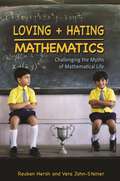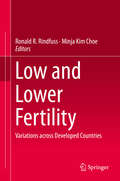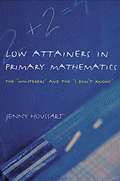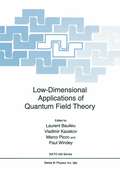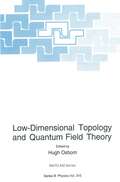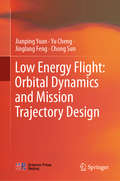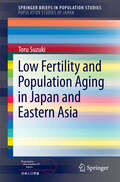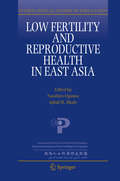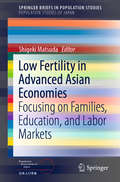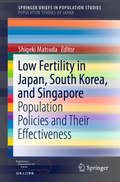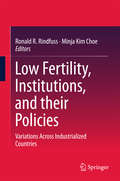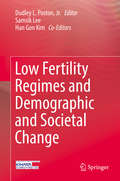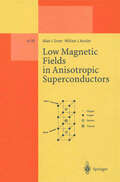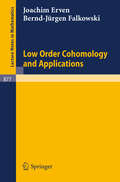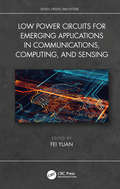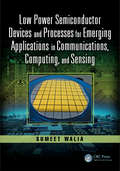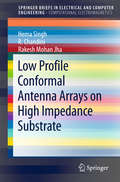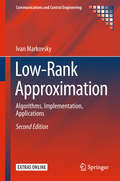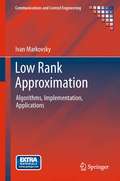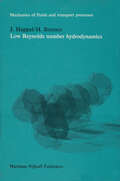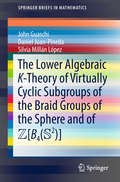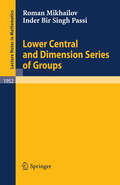- Table View
- List View
Loving and Hating Mathematics: Challenging the Myths of Mathematical Life
by Reuben Hersh Vera John-SteinerMathematics is often thought of as the coldest expression of pure reason. But few subjects provoke hotter emotions--and inspire more love and hatred--than mathematics. And although math is frequently idealized as floating above the messiness of human life, its story is nothing if not human; often, it is all too human. Loving and Hating Mathematics is about the hidden human, emotional, and social forces that shape mathematics and affect the experiences of students and mathematicians. Written in a lively, accessible style, and filled with gripping stories and anecdotes, Loving and Hating Mathematics brings home the intense pleasures and pains of mathematical life. These stories challenge many myths, including the notions that mathematics is a solitary pursuit and a "young man's game," the belief that mathematicians are emotionally different from other people, and even the idea that to be a great mathematician it helps to be a little bit crazy. Reuben Hersh and Vera John-Steiner tell stories of lives in math from their very beginnings through old age, including accounts of teaching and mentoring, friendships and rivalries, love affairs and marriages, and the experiences of women and minorities in a field that has traditionally been unfriendly to both. Included here are also stories of people for whom mathematics has been an immense solace during times of crisis, war, and even imprisonment--as well as of those rare individuals driven to insanity and even murder by an obsession with math. This is a book for anyone who wants to understand why the most rational of human endeavors is at the same time one of the most emotional.
Low and Lower Fertility: Variations across Developed Countries (Springerbriefs In Population Studies)
by Ronald R. Rindfuss Minja Kim ChoeThis volume examines two distinct low fertility scenarios that have emerged in economically advanced countries since the turn of the 20th century: one in which fertility is at or near replacement-level and the other where fertility is well below replacement. It explores the way various institutions, histories and cultures influence fertility in a diverse range of countries in Asia, Europe, North America and Australia. The book features invited papers from the Conference on Low Fertility, Population Aging and Population Policy, held December 2013 and co-sponsored by the East-West Center and the Korea Institute for Health and Social Affairs (KIHASA). It first presents an overview of the demographic and policy implications of the two low fertility scenarios. Next, the book explores five countries currently experiencing low fertility rates: China, Hong Kong, Japan, Singapore and South Korea. It then examines three countries that have close to replacement-level fertility: Australia, the Netherlands and the United States. Each country is featured in a separate chapter written by a demographer with expert knowledge in the area. Very low fertility is linked to a number of conditions countries face, including a declining population size. At the same time, low fertility and its effect on the age structure, threatens social welfare policies. This book goes beyond the technical to examine the core institutional, policy and cultural factors behind this increasingly important issue. It helps readers to make cross-country comparisons and gain insight into how diverse institutions, policies and culture shape fertility levels and patterns.
Low Attainers in Primary Mathematics: The Whisperers and the Maths Fairy
by Jenny HoussartIn this fascinating book, Jenny Houssart draws on close observations with children in lower mathematics sets in primary schools to investigate why some children opt out of mathematics at an early age. After introducing us to the children, she addresses a particular type of mathematical task in each chapter, including: mental work practical work written work calculators and computers assessment tasks. Through the use of stories and quotes, the author shows how the children respond to specific tasks and presents evidence of a range of difficulties that emerge as the children are working. Each chapter ends with discussions and implications for classroom practice. Low Attainers in Primary Mathematics will be a useful resource for primary teachers, student teachers, SENCOs and teaching assistants who will all recognise these children from their own classrooms and draw insights from this highly readable book.
Low Attainers in Primary Mathematics: The Whisperers and the Maths Fairy
by Jenny HoussartIn this fascinating book, Jenny Houssart draws on close observations with children in lower mathematics sets in primary schools to investigate why some children opt out of mathematics at an early age. After introducing us to the children, she addresses a particular type of mathematical task in each chapter, including: mental work practical work written work calculators and computers assessment tasks. Through the use of stories and quotes, the author shows how the children respond to specific tasks and presents evidence of a range of difficulties that emerge as the children are working. Each chapter ends with discussions and implications for classroom practice. Low Attainers in Primary Mathematics will be a useful resource for primary teachers, student teachers, SENCOs and teaching assistants who will all recognise these children from their own classrooms and draw insights from this highly readable book.
Low-Dimensional Applications of Quantum Field Theory (Nato Science Series B: #361)
by L. Baulieu Vladimir Kazakov Marco Picco Paul WindeyThe Cargese Summer School "Low Dimensional Applications of Quantum Field Theory" was held in July 1995. The School was dedicated to the memory of Claude Itzykson. This session focused on the recent progress in quantum field theory in two dimen sions with a particular emphasis on integrable models and applications of quantum field theory to condensed matter physics. A large fraction of the school was also devoted to a detailed review of the exciting developments in four dimensional super symmetric Yang-Mills theory. The diversity of the topics presented constitute, in our opinion, one of the most attractive features of these proceedings. Some contributions constitute a very thor ough introduction to their subject matter and should be helpful to advanced students in the field while others present entirely new research, not previously published, and should be of considerable interest to the specialist. There were in depth introductory lectures on the application of conformal field theory techniques to disordered systems, on the quantum Hall effect, on quantum in tegrable systems, on the thermodynamic Bethe Ansatz and on the new developments in supersymmetric gauges theories. The computation of the three point function of the Liouville model using conformal bootstrap methods was presented in detail.
Low-Dimensional Topology and Quantum Field Theory (Nato Science Series B: #315)
by Hugh OsbornThe motivations, goals and general culture of theoretical physics and mathematics are different. Most practitioners of either discipline have no necessity for most of the time to keep abreast of the latest developments in the other. However on occasion newly developed mathematical concepts become relevant in theoretical physics and the less rigorous theoretical physics framework may prove valuable in understanding and suggesting new theorems and approaches in pure mathematics. Such interdis ciplinary successes invariably cause much rejoicing, as over a prodigal son returned. In recent years the framework provided by quantum field theory and functional in tegrals, developed over half a century in theoretical physics, have proved a fertile soil for developments in low dimensional topology and especially knot theory. Given this background it was particularly pleasing that NATO was able to generously sup port an Advanced Research Workshop to be held in Cambridge, England from 6th to 12th September 1992 with the title Low Dimensional Topology and Quantum Field Theory. Although independently organised this overlapped as far as some speak ers were concerned with a longer term programme with the same title organised by Professor M Green, Professor E Corrigan and Dr R Lickorish. The contents of this proceedings of the workshop demonstrate the breadth of topics now of interest on the interface between theoretical physics and mathematics as well as the sophistication of the mathematical tools required in current theoretical physics.
Low Energy Flight: Orbital Dynamics and Mission Trajectory Design
by Jianping Yuan Yu Cheng Jinglang Feng Chong SunThe book focuses on the orbital dynamics and mission trajectory (transfer or target trajectory) design of low-energy flight in the context of modern astrodynamics. It investigates various topics that either offer new methods for solving classical problems or address emerging problems that have yet to be studied, including low-thrust transfer trajectory design using the virtual gravity field method; transfer in the three-body system using invariant manifolds; formation flying under space-borne artificial magnetic fields; and the orbital dynamics of highly irregular asteroids. It also features an extensive study of the orbital dynamics in the vicinity of contact binary asteroids, including the 1:1 ground-track resonance, the equilibrium points and their stability, and the third-order analytical solution of orbital motion in the vicinity of the non-collinear equilibrium point. Given its breadth of coverage, the book offers a valuable reference guide for all engineers and researchers interested in the potential applications of low-energy space missions.
Low Fertility and Population Aging in Japan and Eastern Asia (SpringerBriefs in Population Studies)
by Toru SuzukiThis book provides a unique comparative view of the extremely low fertility and drastic population aging in Eastern Asian countries. After discussing demographic and political developments of Japan in detail as a reference case, accelerated changes in Korea, Taiwan and China are interpreted with a comparative cultural view. In addition to the well-known cultural divide between countries with strong and weak family ties, this book proposes another divide between offspring of the feudal family and that of the Confucian family. Included is a discussion of how the discrepancy between the compressed change in the socioeconomic system and the slow change in the family system has resulted in extremely low fertility in Eastern Asia. A comparison of policy development reveals that the sense of overpopulation has caused difficulty in launching pro-natal policy interventions in Eastern Asia, especially in China. Impacts of fertility decline on population aging, total dependency ratio and the timing of population decline in Eastern Asia are analyzed with a stylized model. The remaining Confucian family pattern is especially important in understanding and predicting political development to cope with accelerated population aging. This book is a valuable resource for researchers who are interested in the latest and most surprising demographic phenomena in the region.
Low Fertility and Reproductive Health in East Asia (International Studies in Population #11)
by Naohiro Ogawa Iqbal H. ShahThis book provides a unique blend of social and biomedical sciences in the field of low fertility and reproductive health. It offers a significant contribution to understanding the determinants of low fertility mostly in East Asia, including an assessment of the effectiveness of policies that aim to raise fertility. It introduces new analytical tools and methods and shares application of innovative approaches to analyzing cross-sectional and longitudinal survey data and macro socioeconomic data to shed light on changing mechanisms of low fertility in the context of reproductive health.The volume introduces the demographic dividend into the study of fertility, analyzes possible impact of population ageing on the amount of resources allocated to child rearing, i.e. the so called "crowding effect" in social care and public spending between the elderly and children. The book also tests the Low Fertility Trap (LFT) hypothesis, a new important theory regarding fertility trends.The book focuses on East Asia which is numerically large but relatively under-researched with regard to issues covered in various chapters. The relevance of the volume, however, goes beyond countries in East Asia.The book breaks new grounds and reveals little known facts regarding the influence of endocrine disruptors on male fertility through falling sperm counts, the phenomenon of marital sexlessness and about the sexual behavior of adolescents in East Asia.
Low Fertility in Advanced Asian Economies: Focusing on Families, Education, and Labor Markets (SpringerBriefs in Population Studies)
by Shigeki MatsudaThis book focuses on the links between family, education, and employment systems in the Asian developed economies, proposing that these three systems and their interrelations are powerful factors causing the low fertility in Asia.The phenomenon of low fertility has been widely observed in developed countries, and the birthrate in Asian countries is among the lowest in the world. Although these countries have implemented measures to counter the falling birthrate, the expected effect has not yet been achieved. Moreover, Asia has seen a rapid decrease in the number of marriages. To promote effective countermeasures, it is necessary to clarify the factors influencing the low birthrate and decline in the number of marriages. Based on a statistical analysis of survey results mainly from Japan, South Korea, and Singapore, this book discusses several important points. First, because the family system is strong, cohabitation and children born to single mothers are not socially accepted. Further, mothers play a strong role in fulfilling expectations for children’s education. Second, the popularization of higher education and intense academic competition, which have been a driving force for rapid economic growth, have led to many parents opting to have fewer children, as the cost of education is high. Lastly, wage disparity is large and employment stability is a matter of concern. These factors increase competition within education and, in turn, make it difficult for the young generation to choose marriage. Within the employment environment, balancing work and family life is problematical, especially for women.
Low Fertility in Japan, South Korea, and Singapore: Population Policies and Their Effectiveness (SpringerBriefs in Population Studies)
by Shigeki MatsudaThis book describes the low fertility status in three developed Asian countries—Japan, South Korea, and Singapore—and outlines countermeasures for their declining birthrates. Based on the characteristics of each society, the authors discuss why their fertility rates have not yet recovered. Low fertility is a demographic phenomenon that first occurred in Europe and subsequently spread across other countries. Currently, the fertility rates in Europe are relatively stable, while those in developed Asian economies are the lowest worldwide. This may cause labor shortages and weaken their social security systems, undermining Asia’s social and economic sustainability despite its remarkable economic development. In response to low fertility, some Asian countries have implemented countermeasures: Japan has introduced measures based on childcare facilities and work–life balance. Similarly, since the mid-2000s South Korea has established countermeasures to promote a balance between work and child rearing, as well as expanded childcare services. Singapore began introducing countermeasures before the other two countries, including various advanced measures. Yet none of these countries has seen a full recovery in fertility rates. Based on a statistical analysis of survey results from the three countries, this book makes several important points. The first is that the policy has been ineffective in Japan due to a discrepancy between the needs of parents raising children and those who are the targets of the countermeasures. Second, the work–life balance and child-rearing support measures that have been promoted in Japan and South Korea have not affected the number of children that women want to have. Third, Singaporean values tend to place individual emphasis on competition with oneself (education and career status) rather than on married life. This intense competition has lowered fertility rates. To restore these rates, each country must promote policies that better address its specific issues.
Low Fertility, Institutions, and their Policies: Variations Across Industrialized Countries
by Ronald R. Rindfuss Minja Kim ChoeThis volume examines ten economically advanced countries in Europe and Asia that have experienced different levels of fertility decline. It offers readers a cross-country perspective on the causes and consequences of low birth rates and the different policy responses to this worrying trend.The countries examined are not only diverse geographically, historically, and culturally, but also have different policies and institutions in place. They include six very-low-fertility countries (Austria, Czech Republic, Hungary, Italy, Spain, and Taiwan) and four that have close to replacement-level fertility (United Kingdom, Norway, Canada, and France). Although fertility has gone down in all these countries over the past 50 years, the chapters examine the institutional, policy, and cultural factors that have led some countries to have much lower fertility rates than others. In addition, the final chapter provides a cross-country comparison of individual perceptions about obstacles to fertility, based on survey data, and government support for families. This broad overview, along with a general introduction, helps put the specific country papers in context. As birth rates continue to decline, there is increasing concern about the fate of social welfare systems, including healthcare and programs for the elderly. This book will help readers to better understand the root causes of such problems with its insightful discussion on how a country’s institutions, policies, and culture shape fertility trends and levels.
Low Fertility Regimes and Demographic and Societal Change
by Dudley L. Poston Jr. Samsik Lee Han Gon KimThis book explores how low fertility levels could fundamentally change a country's population and society. It analyzes the profound effects below average birthrates have on virtually all aspects of society, from the economy to religion, from marriage to gender roles. An introduction written by Dudley L. Poston Jr. provides a general overview of this relatively new phenomenon that has already impacted nearly one-half of the countries of the world today. Poston also discusses the broad implications of the changes that these societies are currently experiencing and the ones that they will soon confront. Next, each of the 12 essays collected in this volume look into how a low fertility level affects a particular demographic or societal structure or process. In addition, case studies offer an in-depth portrait of these changes in the United States and China. Coverage includes the dynamics of low and lowest-low (where the birthrate is well below average) fertility, high and increasing life expectancies in the United States, the implications of native-born fertility and other socio-demographic changes for less-skilled U.S. immigration, ageing and age dependency in post-industrial societies, good mothering and gender roles in China, the increasing prevalence of voluntary childlessness, how low fertility and prolonged longevity could result in slow economic growth, the decreasing relevance of traditional religious systems, and more. The emergence and persistence of population decline produced by low fertility levels has the potential to greatly alter key aspects of society as well as individual lives. Containing insightful analysis from some of the top minds in demography today, this book will arm readers with the knowledge they need to fully understand these transformations.
Low Magnetic Fields in Anisotropic Superconductors (Lecture Notes in Physics Monographs #30)
by Allan J. Greer William J. KosslerSuperconductors have been known about since the turn ofthe century. Recently there has been a renewed interest with the discovery of the new, high-Tc materials since 1986[1]. These compounds become superconducting at much warmer temperatures than any pre viously known. In fact, many of tthem superconduct at temperatures above the boiling point of liquid nitrogen, making the observation of the transition both accessible and inexpensive. It was obvious immediately that these materials could have a tremendous technological impact, or lead to further materials with even higher transitions. For this reason there has been an intense effort by scientists in both academia and industry to study these materials. The scientificand industrial communitieshope to learn what makes these materials work. For, learning how these materials work not only increases mankind's overall knowledge of his world, but could make some person or company quite successful if the information were used and developed correctly.
Low Order Cohomology and Applications (Lecture Notes in Mathematics #877)
by J. Erven B.-J. FalkowskiLow Power Circuits for Emerging Applications in Communications, Computing, and Sensing (Devices, Circuits, and Systems)
by Fei YuanThe book addresses the need to investigate new approaches to lower energy requirement in multiple application areas and serves as a guide into emerging circuit technologies. It explores revolutionary device concepts, sensors, and associated circuits and architectures that will greatly extend the practical engineering limits of energy-efficient computation. The book responds to the need to develop disruptive new system architecutres, circuit microarchitectures, and attendant device and interconnect technology aimed at achieving the highest level of computational energy efficiency for general purpose computing systems. Features Discusses unique technologies and material only available in specialized journal and conferences Covers emerging applications areas, such as ultra low power communications, emerging bio-electronics, and operation in extreme environments Explores broad circuit operation, ex. analog, RF, memory, and digital circuits Contains practical applications in the engineering field, as well as graduate studies Written by international experts from both academia and industry
Low Power Circuits for Emerging Applications in Communications, Computing, and Sensing (Devices, Circuits, and Systems)
by Fei YuanThe book addresses the need to investigate new approaches to lower energy requirement in multiple application areas and serves as a guide into emerging circuit technologies. It explores revolutionary device concepts, sensors, and associated circuits and architectures that will greatly extend the practical engineering limits of energy-efficient computation. The book responds to the need to develop disruptive new system architecutres, circuit microarchitectures, and attendant device and interconnect technology aimed at achieving the highest level of computational energy efficiency for general purpose computing systems. Features Discusses unique technologies and material only available in specialized journal and conferences Covers emerging applications areas, such as ultra low power communications, emerging bio-electronics, and operation in extreme environments Explores broad circuit operation, ex. analog, RF, memory, and digital circuits Contains practical applications in the engineering field, as well as graduate studies Written by international experts from both academia and industry
Low Power Semiconductor Devices and Processes for Emerging Applications in Communications, Computing, and Sensing (Devices, Circuits, and Systems)
by Sumeet WaliaThe book addresses the need to investigate new approaches to lower energy requirement in multiple application areas and serves as a guide into emerging circuit technologies. It explores revolutionary device concepts, sensors, and associated circuits and architectures that will greatly extend the practical engineering limits of energy-efficient computation. The book responds to the need to develop disruptive new system architectures and semiconductor processes aimed at achieving the highest level of computational energy efficiency for general purpose computing systems. Discusses unique technologies and material only available in specialized journal and conferences. Covers emerging materials and device structures, such as ultra-low power technologies, nanoelectronics, and microsystem manufacturing. Explores semiconductor processing and manufacturing, device design, and performance. Contains practical applications in the engineering field, as well as graduate studies. Written by international experts from both academia and industry.
Low Power Semiconductor Devices and Processes for Emerging Applications in Communications, Computing, and Sensing (Devices, Circuits, and Systems)
by Sumeet WaliaThe book addresses the need to investigate new approaches to lower energy requirement in multiple application areas and serves as a guide into emerging circuit technologies. It explores revolutionary device concepts, sensors, and associated circuits and architectures that will greatly extend the practical engineering limits of energy-efficient computation. The book responds to the need to develop disruptive new system architectures and semiconductor processes aimed at achieving the highest level of computational energy efficiency for general purpose computing systems. Discusses unique technologies and material only available in specialized journal and conferences. Covers emerging materials and device structures, such as ultra-low power technologies, nanoelectronics, and microsystem manufacturing. Explores semiconductor processing and manufacturing, device design, and performance. Contains practical applications in the engineering field, as well as graduate studies. Written by international experts from both academia and industry.
Low Profile Conformal Antenna Arrays on High Impedance Substrate (SpringerBriefs in Electrical and Computer Engineering)
by Hema Singh R. Chandini Rakesh Mohan JhaThis book presents electromagnetic (EM) design and analysis of dipole antenna array over high impedance substrate (HIS). HIS is a preferred substrate for low-profile antenna design, owing to its unique boundary conditions. Such substrates permit radiating elements to be printed on them without any disturbance in the radiation characteristics. Moreover HIS provides improved impedance matching, enhanced bandwidth, and increased broadside directivity owing to total reflection from the reactive surface and high input impedance. This book considers different configurations of HIS for array design on planar and non-planar high-impedance surfaces. Results are presented for cylindrical dipole, printed dipole, and folded dipole over single- and double-layered square-patch-based HIS and dogbone-based HIS. The performance of antenna arrays is analyzed in terms of performance parameters such as return loss and radiation pattern. The design presented shows acceptable return loss and mainlobe gain of radiation pattern. This book provides an insight to EM design and analysis of conformal arrays. This book serves as an introduction for beginners in the design and analysis of HIS-based antenna arrays. It includes pictorial description of both planar and non-planar array design and the detailed discussion of the performance analysis of HIS-based planar and non-planar antenna array. It will prove useful to researchers and professionals, alike.
Low-Rank Approximation: Algorithms, Implementation, Applications (Communications and Control Engineering)
by Ivan MarkovskyThis book is a comprehensive exposition of the theory, algorithms, and applications of structured low-rank approximation. Local optimization methods and effective suboptimal convex relaxations for Toeplitz, Hankel, and Sylvester structured problems are presented. A major part of the text is devoted to application of the theory with a range of applications from systems and control theory to psychometrics being described. Special knowledge of the application fields is not required.The second edition of /Low-Rank Approximation/ is a thoroughly edited and extensively rewritten revision. It contains new chapters and sections that introduce the topics of:• variable projection for structured low-rank approximation;• missing data estimation;• data-driven filtering and control;• stochastic model representation and identification;• identification of polynomial time-invariant systems; and• blind identification with deterministic input model.The book is complemented by a software implementation of the methods presented, which makes the theory directly applicable in practice. In particular, all numerical examples in the book are included in demonstration files and can be reproduced by the reader. This gives hands-on experience with the theory and methods detailed. In addition, exercises and MATLAB^® /Octave examples will assist the reader quickly to assimilate the theory on a chapter-by-chapter basis.“Each chapter is completed with a new section of exercises to which complete solutions are provided.”Low-Rank Approximation (second edition) is a broad survey of the Low-Rank Approximation theory and applications of its field which will be of direct interest to researchers in system identification, control and systems theory, numerical linear algebra and optimization. The supplementary problems and solutions render it suitable for use in teaching graduate courses in those subjects as well.
Low Rank Approximation: Algorithms, Implementation, Applications (Communications and Control Engineering)
by Ivan MarkovskyData Approximation by Low-complexity Models details the theory, algorithms, and applications of structured low-rank approximation. Efficient local optimization methods and effective suboptimal convex relaxations for Toeplitz, Hankel, and Sylvester structured problems are presented. Much of the text is devoted to describing the applications of the theory including: system and control theory; signal processing; computer algebra for approximate factorization and common divisor computation; computer vision for image deblurring and segmentation; machine learning for information retrieval and clustering; bioinformatics for microarray data analysis; chemometrics for multivariate calibration; and psychometrics for factor analysis. Software implementation of the methods is given, making the theory directly applicable in practice. All numerical examples are included in demonstration files giving hands-on experience and exercises and MATLAB® examples assist in the assimilation of the theory.
Low Reynolds number hydrodynamics: with special applications to particulate media (Mechanics of Fluids and Transport Processes #1)
by J. Happel H. BrennerOne studying the motion of fluids relative to particulate systems is soon impressed by the dichotomy which exists between books covering theoretical and practical aspects. Classical hydrodynamics is largely concerned with perfect fluids which unfortunately exert no forces on the particles past which they move. Practical approaches to subjects like fluidization, sedimentation, and flow through porous media abound in much useful but uncorrelated empirical information. The present book represents an attempt to bridge this gap by providing at least the beginnings of a rational approach to fluid particle dynamics, based on first principles. From the pedagogic viewpoint it seems worthwhile to show that the Navier-Stokes equations, which form the basis of all systematic texts, can be employed for useful practical applications beyond the elementary problems of laminar flow in pipes and Stokes law for the motion of a single particle. Although a suspension may often be viewed as a continuum for practical purposes, it really consists of a discrete collection of particles immersed in an essentially continuous fluid. Consideration of the actual detailed boundary value problems posed by this viewpoint may serve to call attention to the limitation of idealizations which apply to the overall transport properties of a mixture of fluid and solid particles.
The Lower Algebraic K-Theory of Virtually Cyclic Subgroups of the Braid Groups of the Sphere and of ZB4(S2)
by John Guaschi Daniel Juan-Pineda Silvia Millán LópezThis volume deals with the K-theoretical aspects of the group rings of braid groups of the 2-sphere. The lower algebraic K-theory of the finite subgroups of these groups up to eleven strings is computed using a wide variety of tools. Many of the techniques extend to the general case, and the results reveal new K-theoretical phenomena with respect to the previous study of other families of groups. The second part of the manuscript focusses on the case of the 4-string braid group of the 2-sphere, which is shown to be hyperbolic in the sense of Gromov. This permits the computation of the infinite maximal virtually cyclic subgroups of this group and their conjugacy classes, and applying the fact that this group satisfies the Fibred Isomorphism Conjecture of Farrell and Jones, leads to an explicit calculation of its lower K-theory. Researchers and graduate students working in K-theory and surface braid groups will constitute the primary audience of the manuscript, particularly those interested in the Fibred Isomorphism Conjecture, and the computation of Nil groups and the lower algebraic K-groups of group rings. The manuscript will also provide a useful resource to researchers who wish to learn the techniques needed to calculate lower algebraic K-groups, and the bibliography brings together a large number of references in this respect.
Lower Central and Dimension Series of Groups (Lecture Notes in Mathematics #1952)
by Roman Mikhailov Inder Bir PassiA fundamental object of study in group theory is the lower central series of groups. Understanding its relationship with the dimension series, which consists of the subgroups determined by the augmentation powers, is a challenging task. This monograph presents an exposition of different methods for investigating this relationship. In addition to group theorists, the results are also of interest to topologists and number theorists. The approach is mainly combinatorial and homological. A novel feature is an exposition of simplicial methods for the study of problems in group theory.
